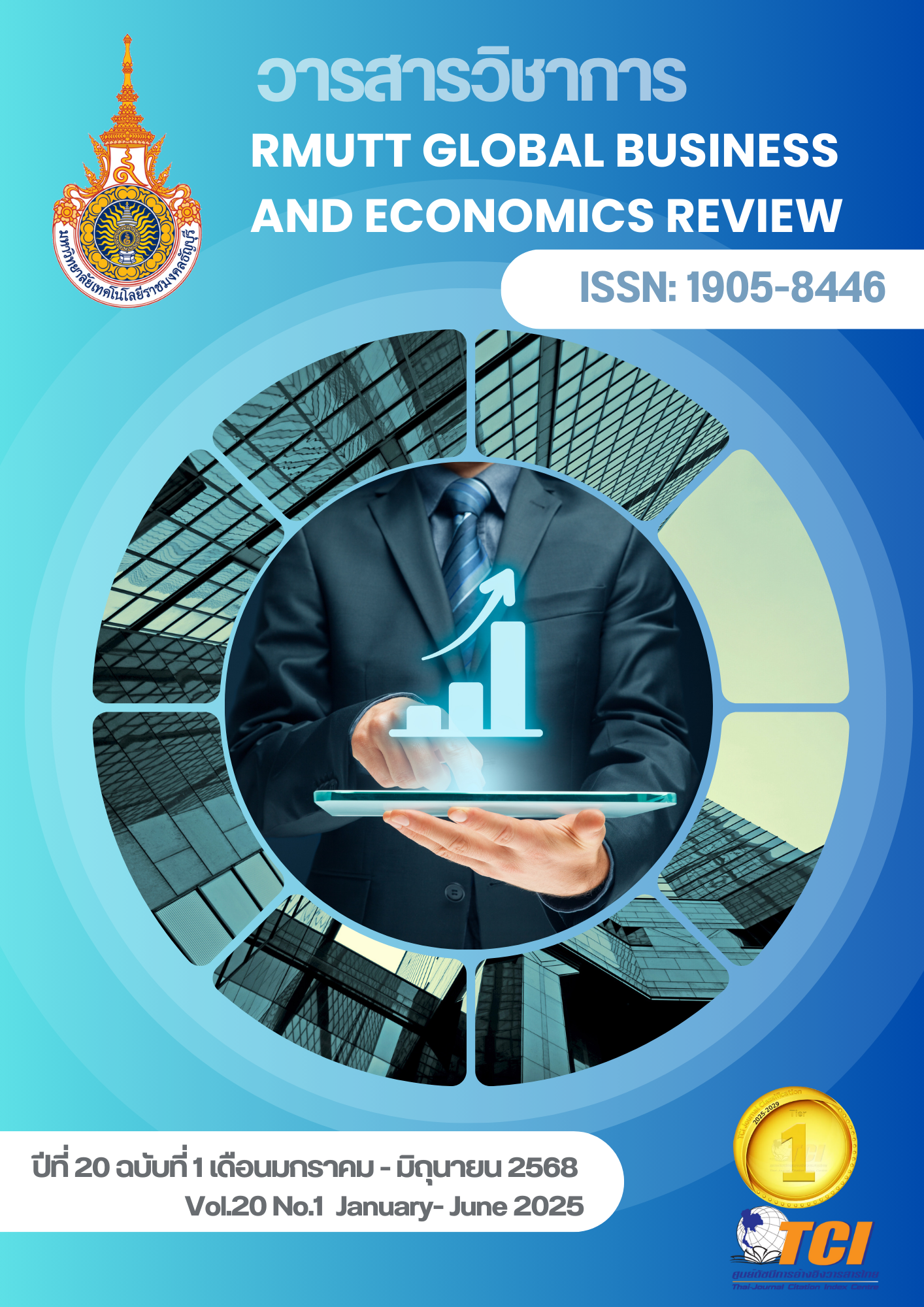บุพปัจจัยที่มีอิทธิพลต่อประสิทธิผลการพัฒนาธุรกิจเครื่องประดับเงินแท้อย่างยั่งยืนในประเทศไทย
DOI:
https://doi.org/10.60101/rmuttgber.2025.280704คำสำคัญ:
ธุรกิจเครื่องประดับเงินแท้ , ประสิทธิผลการพัฒนา , การพัฒนาอย่างยั่งยืนบทคัดย่อ
งานวิจัยนี้มีวัตถุประสงค์เพื่อ 1) ศึกษาประสิทธิผลการพัฒนาธุรกิจเครื่องประดับเงินแท้อย่างยั่งยืนในประเทศไทย 2) วิเคราะห์ปัจจัยเชิงสาเหตุที่มีผลต่อประสิทธิผลการพัฒนา และ 3) เสนอแนวทางการพัฒนาธุรกิจเครื่องประดับเงินแท้อย่างยั่งยืนในประเทศไทย การวิจัยใช้กลุ่มตัวอย่างเป็นผู้ประกอบการ เจ้าของธุรกิจ และตัวแทนธุรกิจเครื่องประดับเงินแท้ในประเทศไทย จำนวน 400 คน รวมถึงผู้ให้ข้อมูลสำคัญ จำนวน 17 คน สถิติที่ใช้ในการศึกษา ได้แก่ ความถี่ ค่าร้อยละ ค่าเฉลี่ย ส่วนเบี่ยงเบนมาตรฐาน และการวิเคราะห์โมเดลสมการโครงสร้าง (SEM) ผลการศึกษา พบว่า 1) ประสิทธิผลการพัฒนาธุรกิจเครื่องประดับเงินแท้อย่างยั่งยืนในประเทศไทยแสดงให้เห็นว่าด้านเศรษฐกิจ ตลาดเติบโต ช่วยเพิ่มการแข่งขันและโอกาสในสังคม ด้านสังคมสร้างความภาคภูมิใจและความเชื่อมั่น ด้านสิ่งแวดล้อมลดการใช้พลังงานในกระบวนการผลิต 2) ปัจจัยเชิงสาเหตุที่มีผลต่อประสิทธิผล ได้แก่ นวัตกรรมสีเขียวมีผลต่อกลยุทธ์การตลาดและประสิทธิผลของธุรกิจ กลยุทธ์การตลาดมีผลต่อคุณค่าตราสินค้าและประสิทธิผลของธุรกิจ และคุณค่าตราสินค้าส่งผลต่อประสิทธิผลของธุรกิจ 3) แนวทางการพัฒนา ได้แก่ การใช้กลยุทธ์การตลาดที่เหมาะสม การออกแบบผลิตภัณฑ์ตามความต้องการตลาด การใช้เทคโนโลยีและวัสดุที่เป็นมิตรกับสิ่งแวดล้อม รวมถึงการมุ่งมั่นในคุณภาพและการสื่อสารที่ดีเพื่อสร้างความน่าเชื่อถือและความยั่งยืนในระยะยาว
References
กรมส่งเสริมการค้าระหว่างประเทศ. (2564). รายงานประจำปี 2564 กรมส่งเสริมการค้าระหว่างประเทศ. สืบค้นจาก https://dl.parliament.go.th/
ธรรมรักษ์ ละอองนวล หทัยรัตน์ ไชยศาสตร์ และวิรัญญา สุทธิกุล. (2566). แนวทางความสำเร็จของวิสาหกิจชุมชนช่างชุบเงินและชุบทองในศูนย์ศิลปาชีพแห่งประเทศไทย. Journal of Namibian Studies: History Politics Culture, 33, 1229-1244.
พรชนก ทองลาด ไพฑูรย์ อินต๊ะขัน และบัณฑิต บุษบา. (2559). แนวทางการพัฒนาธุรกิจให้มีความยั่งยืน ตามปรัชญาเศรษฐกิจพอ เพียงของธุรกิจขนาดกลางและขนาดย่อมในจังหวัดลำปาง ลำพูน และเชียงใหม่. วารสารสมาคมนักวิจัย, 21(1), 74-87.
ศิริวรรณ เสรีรัตน์. (2552). การบริหารการตลาด. กรุงเทพฯ: พัฒนาศึกษา.
สุดแดน วิสุทธิลักษณ์. (2560). มรดกภูมิปัญญาทางวัฒนธรรมของชาติ: บทเรียนจากเพื่อนบ้าน. กรุงเทพฯ: ศูนย์มานุษยวิทยาสิรินธร (องค์กรมหาชน).
Dataforthai. (2566). ผู้ประกอบการเครื่องประดับเงินแท้ในประเทศไทย. สืบค้นจาก https://www.dataforthai.com/
Enkhtuvshin, E., & Chae-Deug, Y. (2019). Sustainable Growth Factors of SMEs in Developing Countries-Focus on Creating an Ecosystem to the Jewelry Industry in Indonesia. 한복문화, 22(4), 125-142.
Fu, E., Spiegelhalder, R., Vogt, S., & Goebel, M. (2022). The best kept secret in laser additive manufacturing: green lasers, a unique innovation. In Laser 3DManufacturing IX , 11992, 1199202.
Greco, M. (2023). Alta Gioielleria" Green"= High Green Jewellery. (Doctoral dissertation,Politecnico di Torino).
Kanagal, N. B. (2015). Innovation and product innovation in marketing strategy. Journal of Management and Marketing Research, 18(1),1-25.
Kushwaha, M. (2022). Innovation in Coin Jewellery fashioned with Enameling and Semi-Precious Stones. Journal of Development and Social Sciences, 3(4), 266-278.
Lin, S., Fang, M. X., & Li, Z. (2020, December). 3D Print Innovative Design of Painted Silver Jewelry: A case study of painted silver bracelets in porch windows. In 2020 International Conference on Innovation Design and Digital Technology (ICIDDT), 436-440, IEEE.
Parfonova, S. (2023). Analysis of Jewelry Brand Marketing Management Strategies Based on Consumer Psychology. Highlights in Business, Economics and Management, 18, 153-157.
Pozzobon Palma, E., Maffini Gomes, C., Marques Kneipp, J., & Aparecida Barbieri da Rosa, L. (2014). Sustainable strategies and Export Performance: an analysis of companies in the gems and jewelry industry. Revista Brasileira de Gestão de Negócios, 16(50).
Priskila, S., & Darma, G. S. (2020). Employee Perception of Brand Value in the Jewelry Industry. Journal of Economics, Business, & Accountancy Ventura, 23(2), 267-278.
Roman, P., Jara, J., Surichaqui, R., & Vicente-Ramos, W. (2020). Internal factors that stimulate the internationalization of companies in Peru’s jewellery sector. Business: Theory and Practice, 21(2), 792-803.
Rocha, H. T., Ferreira, L. P., & Silva, F. J. G. (2018). Analysis and improvement of processes in the jewelry industry. Procedia Manufacturing, 17, 640-646.
Suwandana, I. G. M. (2023). Role of Competitive Advantage in Mediating the Effect of Market Orientation on Marketing Performance of Small Medium Enterprise (SME): Study on the Gold and Silver Jewelry Craft Industry in Singapadu Village, Gianyar, Indonesia. European Journal of Business and Management Research, 8(1), 247-251.
Vatanen, T. (2014). Design and production of jewelry line. Berlin: Retrieved from https://urn.fi/URN:NBN:fi:amk-201405096947.
Wijaya, P. Y., & Suasih, N. N. R. (2020). The effect of knowledge management on competitive advantage and business performance: A study of silver craft SMEs. Entrepreneurial Business and Economics Review, 8(4), 105-121.
Yamane, T. (1967). Statistics An Introductory Analysis. 2nd Edition. New York: Harper and Row.
Downloads
เผยแพร่แล้ว
How to Cite
ฉบับ
บท
License
Copyright (c) 2025 Chaiwat prasartpanyawut, Thanasuwit Tabhiranrak, Sittichai Thammasene

This work is licensed under a Creative Commons Attribution-NonCommercial-NoDerivatives 4.0 International License.
บทความที่ได้รับการตีพิมพ์เป็นลิขสิทธิ์ของผู้นิพนธ์
ข้อความที่ปรากฏในบทความแต่ละเรื่องในวารสารวิชาการเล่มนี้เป็นความคิดเห็นส่วนตัวของผู้เขียนแต่ละท่านไม่เกี่ยวข้องกับมหาวิทยาลัยเทคโนโลยีราชมงคลธัญบุรี และคณาจารย์ท่านอื่นๆในมหาวิทยาลัยฯ แต่อย่างใด ความรับผิดชอบองค์ประกอบทั้งหมดของบทความแต่ละเรื่องเป็นของผู้เขียนแต่ละท่าน หากมีความผิดพลาดใดๆ ผู้เขียนแต่ละท่านจะรับผิดชอบบทความของตนเองแต่ผู้เดียว







